From now on, all Four Color Apocalypse reviews will be on my Patreon, where I am offering a mix of freely-available and paywall content. Join us over there and please consider subscribing!
The Devil Is In The Details — But God Might Be, Too : David Tea’s “Five Perennial Virtues” #12 : “Pearl”

Something tells me that if the late, great Steve Ditko didn’t harbor a sense of utter disdain for mysticism (I know, I know, weird considering he created the character of Dr. Strange) that he’d like David Tea’s comics : intricate bordering on the obsessive, singular in their approach, making little to no allowances for popular taste, and more than a trifle inflicted with/influenced by (depending upon one’s point of view) a kind of esoterically-flavored cultural and even political conservatism that probably doesn’t have much of a place in the MAGA clown car even though it shares at least a few of its goals, Tea strikes me as Ditko’s heir apparent and antithesis in almost equal measure, a “fellow traveler” who set out on a separate path. One that, crucially, doesn’t preclude the direct involvement of the supernatural in everyday life.
And, really, everyday life has always been — and remains — Tea’s focus, but he has a way of making even its most mundane minutiae seem interesting, alien, and altogether new. In the same way that a cat can be utterly enthralled with going after the same piece of string for the 10,000th time (and Tea has actually made a comic about that very subject), the unfolding episodic narrative that is Five Perennial Virtues can follow the same basic formula with entirely different results each issue.
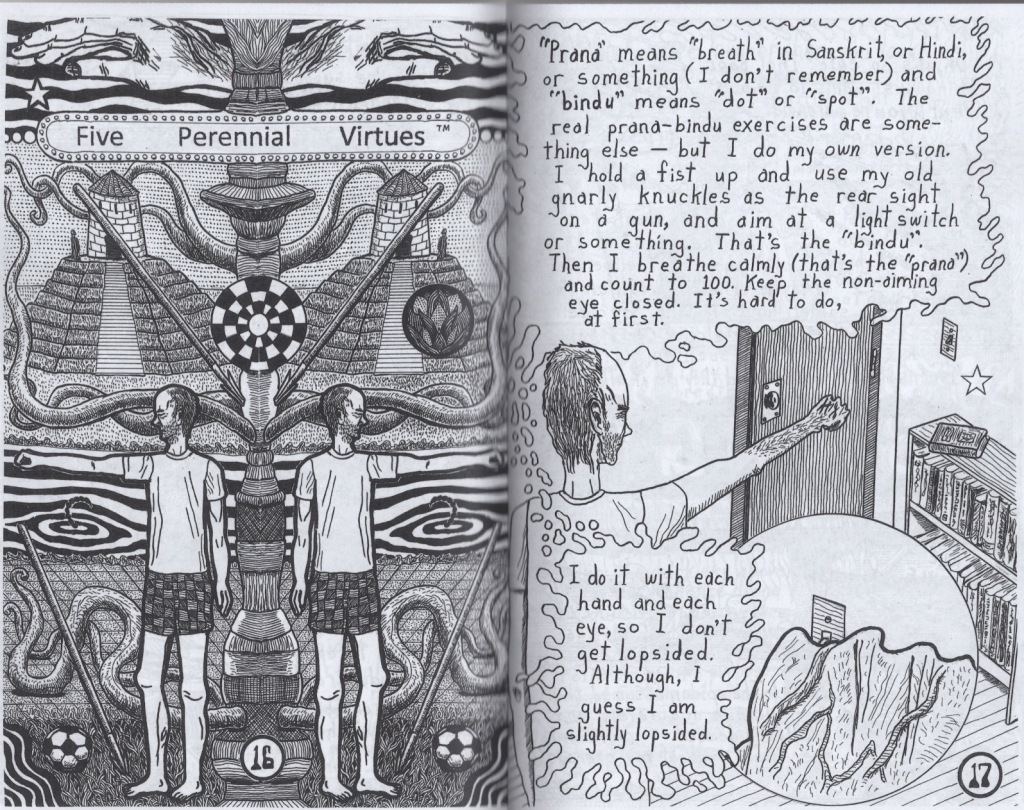
Although, in absolute fairness, “results” may not be what this comic is even after — as cliched as it is to say something is “all about the journey,” in this case it’s nevertheless absolutely true. Issue number twelve of Tea’s irregularly self-published series, subtitled “Pearl,” has just been released and is laden with explication, extrapolation, and explanation — some pages are quite literally a “wall of text” — and yet, as is the case with life itself, we’re no “further along” in many key respects at the end than we were at the start. Hell, it remains an open question how much of this narrative is “real” and how much is a “dream,” but the damned thing is : at some point you stop caring about such trivialities and just accept what’s unfolding on the page for what it is — whatever that may be.
For my own part, I’ve long since stopped trying to define what I term, in wholly unoriginal fashion, the “David Tea comics experience,” and just kind of surrendered to it. This isn’t work that takes a page from any particular playbook or stylistic tradition, but likewise it’s too well-versed in the tropes and trappings of sequential storytelling for me to feel comfortable labeling it as “outsider art.” Tea is clearly schooled in how comics have been made — in how, the narrow-minded would argue, they “should” be made — but either through conscious disregard of said strictures or distinct lack of interest in maintaining/perpetuating them, his work has achieved, and continues to build upon, a loose visual and narrative language entirely its own.
There is no mistaking a comic by this dude for a comic by anyone else.
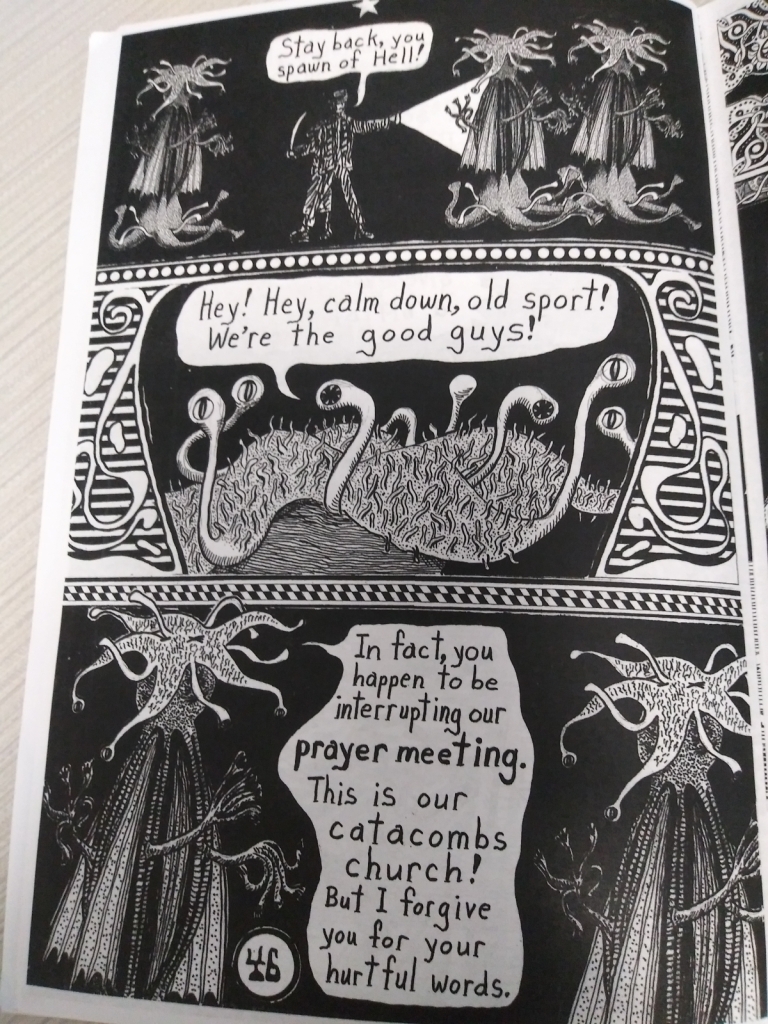
It is, therefore, wholly accurate to say that the nuts and bolts of what’s happening in Five Perennial Virtues #12 can be summed up as : “disheveled (possibly homeless?) Dave meets an attractive and interesting young lady, behaves oddly, and weird things happen — plus fourth-wall-busting philosophical asides,” but the thing about truth and accuracy that makes it such a pain in the ass is that it’s far too confining to apply to art. And so, as with the set-up of one of Tea’s plots, I look at the entirety of these comics as a springboard to something else, some other way of observing life on the one hand but also experiencing it on the other. I don’t know if that’s the intention, but then I don’t know that Tea can be accused of even having something as pedestrian as an “intention” in the first place. I recall, for instance, asking him a few years back when I interviewed him what his titular five perennial virtues were, and he told me that he was still figuring that out — but that he was pretty sure that, yes, there were five of them.

Take a moment and let that sink in : with nearly two decades of cartooning under his belt — a point at which most of his “peers” think they’ve got more or less everything figured out — David Tea is still feeling his way forward, learning on the job, deciding both what the hell he wants to do with his art and how he wants to do it. And that, right there, is what makes his comics not only interesting, but vital. Time will tell if the repeating symbolism and Biblical asides of “Pearl” are things he returns to or discards in future issues — if this is a taste of things to come or a one-off aside — but we needn’t worry either way : Tea will do what feels right on the page at the time, just as he’s done here.
Just as he always has. After all, I don’t think it’s ever been about creating the so-called “perfect” comic with this guy : it’s about creating a comic that is perfectly itself. His always are.
*****************************************************************
Five Perennial Virtues #12 : “Pearl” is available for $7.00 from Austin English’s Domino Books distro at http://dominobooks.org/fiveperennial12.html
Also, this review — and all others around these parts — is “brought to you” by my Patreon site, where I serve up exclusive thrice-weekly rants and ramblings on the worlds of comics, films, television, literature, and politics for as little as a dollar a month. Subscribing is the best way to support my continuing work, so I’d be very appreciative if you’d take a moment to give it a look by directing your kind attention to https://www.patreon.com/fourcolorapocalypse
Do Comics Publishers Need Readers Anymore? Part Two

If you look at the copyright indicia notices typically printed on the inside front covers of most nominally “independent” comics, you’ll find that the trademarks for the book in question — as well those for all its characters, their distinct likenesses, and what have you — are jointly held by the principal members of that comic’s so-called “creative team.” Generally that means the writer and the artist, unless the comic was made by a real CARTOONIST who does everything themselves, but I’ve seen select instances where the colorist and even the letterer are in on a piece of the action, as well. This is the good side of creator ownership, with everything working as it should. But there is, increasingly, a darker side that is seeing a lot of people getting screwed out of their fair share —
For instance, when you look at the copyright indicia in most comics published by Aftershock, Avatar, and Boom! Studios, what you’ll see about eight times out of ten is that the trademarks to the characters and concepts are jointly held by the WRITER and the PUBLISHER, with the artist left out in the cold despite spending more time working on the book than anybody else. That’s because Aftershock, Avatar, and Boom! — and even, increasingly, Dark Horse — take their so-called “pitches” directly from writers, and then hire out a jobbing penciller, inker, or penciller/inker to draw the series that they “green light” on a work-made-for-hire basis. In other words, these poor schmucks are getting the same raw deal they would be getting at Marvel or DC — only probably even worse, because the page rates at these second-and third-tier publishing houses are for shit.

Of course, economically speaking, these publishers have a built-in excuse as to why they don’t pay their talent a decent wage : none of their comics sell. Curiously, though, that doesn’t seem to stop them from making more of them. Consider : Aftershock can’t be said to have published a legitimate “hit” series at any point in its near-ten-year history, and a quick glance at the monthly sales figures shows most of their product charting in the 5,000-6,000 copies sold range — if it even charts in the first place. Many of their titles don’t make the minimum threshold to be ranked at all. Ditto for Avatar, which hasn’t had a real hit outside Crossed and its Alan Moore-scripted series like Neonomicon and Providence. Or how about Boom!, which has somehow survived for well over a decade despite NEVER having a real sales success (not endorsed by Keanu Reeves, that is) until Something Is Killing The Children and its spin-off series, House Of Slaughter, turned up in the last year or two?
Speaking of, the copyrights on those two books are even MORE confusing : writer James Tynion IV and artist Werther Dell’Edera are BOTH credited as the series’ CREATORS, but the books are OWNED by Tynion and Boom!, with Dell’Edera stuck on the outside looking in of his own co-creation. Over at Aftershock, though, things are getting even more ridiculous : their recent series Nuclear Family, written by Stephanie Phillips and drawn by Tony Shasteen, isn’t the property of EITHER creator — it’s the property of the publisher and a Hollywood guy named Eric Bromberg, who “pitched” the project to Aftershock but apparently didn’t feel like actually WORKING on it himself. I was able to confirm that “business model” also applies to Aftershock comics Pestilence and Red Atlantis, and if I had a couple more hours to devote to legwork on this column, I’m sure that I could find more.
But we’re not finished with the absurdity yet, friends. Newer publishers TKO Studios and AWA/Upshot both showed up talking a big game about how “creator-friendly” they were, but ALL of their books are corporate-owned, and the two guys running the show at AWA, Bill Jemas and Axel Alonso. are former Marvel suits. If they wanted to keep sticking it to the talent like this, you have to wonder why they didn’t just stay at their old gigs — oh, that’s right, they were fired.
Both TKO and AWA are still patiently waiting for their fist popular series to come along, as well, but their overall publishing outputs are remaining fairly consistent — hell, AWA seems to be cranking out more and more titles every month. Yet NONE of them sell. How is it, then, that supposedly “indie” publishers find themselves getting more and more stingy in terms of offering REAL creator ownership, even as their books gather dust on the shelves? I mean, why would a publisher even CARE about screwing over one or more of the creators of a series almost no one reads? Why would they accept proposals from Hollywood screenwriters for projects those guys don’t want to put any effort into themselves and that are more or less guaranteed to find their way into dollar bins within a few months?

The answer, of course, is pretty simple : these publishers aren’t looking to have a wide range of successful titles, they’re looking to stumble into a Willy Wonka-esque golden ticket. If just ONE of their comics gets optioned for development by a TV or movie studio, they figure that will make up for all the losses on all this other crap. And if one of those options makes it out of development hell and onto the big or small screen? They’re REALLY swimming in gravy then. These companies aren’t even “comic book publishers” per se — they’re in the business of publishing movie and TV treatments that have the added “plus” of being storyboarded entirely in advance. I assure you I’m not at all exaggerating when I say that sooner rather than later at least one of these mid-level “independents” is going to drop all the pretense, forego distributing their product to comic shops, and just ship it to studio execs and producers off a mailing list.

To return to our original question, then, these comics publishers absolutely DON’T need readers — note the plural. What they need is just ONE random reader, with deep pockets and Tinseltown connections, to look at one of their comics and figure it has the makings of a hit in other media. That’s enough to keep the lights on in the short term. Ultimately, though, what they would REALLY like is the kind of deal Boom! recently got where 20th Century Fox bought a sizable stake in the company and moved their offices right onto the studio lot. Or the deal Dark Horse got, where they sold the company lock, stock, and barrel to a multinational video game giant. The AWAs, Aftershocks, TKOs, and even the Avatars of the world keep plugging away, losses be damned, in hopes of that one MONSTER payday down the line.
******************************************************
Like everything else I’m running this week, this essay originally appeared on my Patreon site, where you get three similar helpings to thoughts straight from yours truly’s id every week. You can subscribe for as little as a dollar a month, and while I’m admittedly biased, I daresay that’s one of the better values going in the entire Patreon racket these days. So come on over, we’re friendly, I promise.
Oh, and I suppose a link would help. Here you go : https://www.patreon.com/fourcolorapocalypse
A Very Personal Masterpiece : Julie Doucet’s “Time Zone J”

As art, as narrative, as formalist exercise, and as graphic literature, there’s no way to describe Julie Doucet’s long-awaited return to the medium she helped revolutionize, the recently-published Time Zone J, as anything other than a triumph. And quite likely a staggering one at that. But that doesn’t mean that getting through it isn’t a fair amount of work.
As with all labors, though, what matters here is how ENJOYABLE the expenditure of energy (in this case MENTAL energy) involved is, and how much VALUE one derives from it. On that score, we as readers needn’t fear, as we’re in the best possible hands, but as a CRITIC, this is a book that puts me in a bit of a tricky wicket because I feel the need to write a “how-to” guide every bit as much as a review. Perhaps I just need to learn to compromise and write something that’s a bit of both?

To begin with, then, Doucet drew — and politely admonishes us to read — each of these pages in “reverse,” bottom-top-top order, but that’s often FAR easier said than done. Drawing on her experience with collage, what Doucet has created here is the nearest thing to its comics equivalent : a miasmic, oftentimes dizzying array of tightly-placed images (usually faces, sometimes animals and objects and buildings, more rarely full-figure drawings) with no artificially-constructed “borders” between them. In purely practical terms, this means that not only are there no “panels” per se, but that each image flows and/or butts up against the next, and that each “side” of each folded page continues onto and into the one next to it. Yes, it’s confusing, but so is life, and you DO get used to it — again, like life. But there ARE numerous occasions where word balloons and the like have to be sort of intuitively organized because there’s no clear visual “running order” provided.
Strangely, though, this doesn’t feel like just haphazard methodology on Doucet’s part : again, I invoke the term “intuited” because it absolutely applies. And it applies to the STORY “structure,” as well, bobbing and weaving as it does between past and present, between Doucet as she is and as she was, and of course part of the fun here is teasing out both the differences and similarities (not only in terms of physical characteristics, but also in terms of outlook, mindset, and personality) between both “versions” of our author/protagonist. There IS a focal point to the narrative — that being the recounting of a painful, abusive, and ultimately doomed relationship between Doucet and a late-1980s/early-1990s paramour she refers to as “The Hussar” — but the circuitous route she travels getting to this series of recollections, as well as the various tributaries that emerge from them, are truthfully every bit as fascinating and involving as is the “meat” of the “plot” itself. Again, the obliteration of any and all demarcation between events and chronologies and their physical representations is absolutely crucial here : this isn’t about how things “begin” or “end,” it’s about showing AND telling that they all blend together, even (perhaps especially?) when said blending is far from seamless.

Viewed from that perspective, it’s no exaggeration to say that Time Zone J is one of the most conceptually and aesthetically HONEST comics you’re ever likely to read, even if the mileage individual readers get from it is BOUND to vary due to its absolutely unique construction. We’re all familiar with the idea that certain works are, as the cliche goes, “easier to respect than they are to like,” but Doucet ups the ante on that considerably here, crafting something that is downright IMPOSSIBLE not to respect REGARDLESS of how much one likes it.

Which sounds, I suppose, as though I might be damning Time Zone J with faint praise, but I assure you nothing could be further from the truth : I LOVED this book and consider it to be the crown jewel in Doucet’s stellar career — yes, I think I like it even more than Dirty Plotte. But it did have to grow on me as I went along — or, perhaps more accurately, I had to grow into it, as it’s something that offers no option apart from meeting it ENTIRELY on its own terms. To my mind, though, that is PRECISELY what an “auteur” work is, and if ever there was a book that lived and breathed an artistic philosophy of uncompromising singularity, it’s this one. Time will tell if it proves to be the year’s BEST comic, of course, but I’d be absolutely flabbergasted if, by calendar’s turn, it stands as anything less than the most IMPORTANT and GROUNDBREKING one.
********************************************************
By way of full disclosure, this review originally ran on my Patreon site and is presented here as part of a devious week-long scheme to entice more people to subscribe to said site.
And, really, if you like my stuff, there’s no reason not to. You get three new reviews/rants/ramblings on the worlds of comics, films, television, literature, and politics for as little as a dollar a month. So do yourself — and, who are we kidding, me — a favor and check it out by heading on over to https://www.patreon.com/fourcolorapocalypse
Do Comics Publishers Need Readers Anymore? Part One

It’s easy to forget now, but when Marvel Studios launched in 2008, the move was met with a fair amount of then-understandable skepticism — after all, not only had the publisher sold away the film and TV rights to most of its “A-list” characters in a series of bad deals largely brokered by Smilin’ Stan Lee himself, they’d also sold off a fair number of “B-listers” as well : Spider-Man was unavailable for them to use, as were the X-Men, but so were also-rans such as Daredevil and The Punisher. The cupboard wasn’t bare, by any means, but properties such as Iron Man and Captain America — while they certainly had their fans — were nothing the major studio players were all that interested in. It’s fair to say, in fact, that at the time of the MCU’s genesis, the most bankable character under the company’s control was The Hulk, the rights to whom had reverted back to Marvel after Universal declined to produce a follow-up to Ang Lee’s 2003 box office disaster featuring the big green guy.
My, how times change. Nearly 15 years on, not only are Iron Man, Captain America, Daredevil, and The Punisher more popular with movie-going audiences than Batman and Superman, people are forking over hefty monthly subscription fees to Disney Plus to watch shows featuring such formerly-bottom-tier characters as Moon Knight, The Vision, Winter Soldier, and Loki. Hell, even joke properties like Ant-Man have become box office gold. Odds are pretty good that, at this point, Marvel would even turn a hefty profit off the likes of Alpha Flight or Damage Control, so insatiable is the public’s appetite for their product.

All of which, believe it or not, is my long-winded way of getting back to the title of this short series and assuring you, dear reader, that the question I’m asking is NOT a rhetorical one — at least not in all cases. Admittedly, there are comics publishers that clearly and obviously DO need readers — in fact, we’ve spilled a generous amount of digital ink on this very site examining how the burgeoning YA market has forever altered the publishing strategy of one company, in particular, as they appear to be abandoning their artistic principles wholesale in an attempt to chase down a readership that may not even be there for the taking at this point and trust me when I say that what’s true for Drawn+Quarterly is just as true for Top Shelf, although the scale is vastly different given the latter puts out five or six books per year while the former puts out 30-40. So, yeah, SOME publishers still rely on people BUYING, READING, and maybe even LIKING their books — but what about everyone else?
Certainly, Marvel’s success in the “wider world” hasn’t translated into any sort of appreciable sales bump for their printed product — the comics market as a whole is slightly up compared to where it was a few years ago, and up a bit more than that if we cast our sights back a decade or so, but the idea that a comic like Thor only moves a thousand or two more copies a month than it did BEFORE three multi-million-dollar blockbusters were extrapolated from it has to be considered something of a disappointment no matter how one chooses to look at it. Ditto for Spider-Man. And The X-Men. And Doctor Strange. And — well, all of ’em. Clearly, then, some sort of fundamental disconnect exists between the “comics crowd” and the “movie crowd,” even when it comes to the EXACT SAME characters and content.

In fact, the two markets are so completely divorced from one another at this point that Marvel and DC aren’t even really bothering with one of the oldest tricks in the book anymore : launching a new series to coincide with the release of a big-budget film. When DC did this back in 1989, releasing the new Batman series Legends Of The Dark Knight at roughly the same time as Tim Burton’s Batman film, the results were spectacular, with LOTDK #1 becoming the biggest-selling comic of the year and the biggest-selling first issue of ANY comic in almost 50 YEARS. By the time 2012 rolled around and Marvel released a new Avengers #1 within weeks of Joss Whedon’s The Avengers movie, though, no one gave a shit and the series fizzled out within a few short years — only to be replaced by ANOTHER new Avengers #1 just in time for the Avengers : Age Of Ultron flick. That title was even shorter-lived, however, and by the time the third and fourth Avengers films rolled around, Marvel had thrown in the towel on the whole concept of cashing in quick with new comics to accompany new movies.
Obviously, then, REALLY popular films don’t translate into comic book sales, but the reverse is also true : REALLY popular comics don’t necessarily lead to box office fortunes. DC has learned this the hard way more than Marvel has, of course, with top-selling titles like Watchmen and top-selling storylines like the death of Superman failing to catch fire with theater-goers (although the widely-held view that Batman V. Superman‘s $900 million box office take represented a “disappointment” may have more to do with a successful “whisper campaign” directed against both the film and its fortunes than it does with financial realities — I mean, come on, I know we live in absurd times, but the idea that a movie that rakes in just under a BILLION DOLLARS is a “flop” is just plain nuts), but in its own way this is just further proof of the argument that I’m laying out, is it not? Comic book CHARACTERS are more popular than ever, but comic books THEMSELVES are almost becoming surplus to requirements, while comic book SALES offer nothing by way of a “leading indicator” as to what will or won’t be popular with the broader, entertainment-starved public.

From a purely logical point of view, nothing about this makes any real sense, of course, but logic also dictates that the super-hero movie craze probably should have died out years ago, yet here we are. As is the case with the multinational banks, then, it appears as though we’ve entered a period of history where at least Marvel, and maybe even DC, are quite simply “too big to fail,” and we’re going to be stuck with them for the rest of our fucking lives — but how long will they even BOTHER sticking with an archaic “delivery system” for their stories?
Already Marvel Unlimited, the company’s digital comics platform, is more or less DARING readers to stick with printed periodicals, given they offer almost everything in the publisher’s vast back catalogue for something like six or seven bucks a month and have gone from having a one-year lag between print and digital availability to a mere a six months, and now just THREE months, while DC is doing their level best to chase off what readers they have left by slowly rolling out an absurdly high $4.99 cover price on more and more of their books. Factor in the inherently limited reach of so-called “direct market” distribution, and you honestly have to wonder if either of these companies even CARES about selling comics anymore, because it sure doesn’t look like it. Sure, they need stories to make movies out of, but more and more often what we see on the big screen bears little to no resemblance to any printed-page antecedent — original screenplays are taking the place of adapted ones, origins of characters are radically altered, entire modern-day mythologies are scrapped in favor of new, POST-modern ones. Hell, if you look at the comic book version of Aquaman and the cinematic version, about all they have in common is a name.
Admittedly, the demise of the monthly “floppy” has been predicted for years now and it has yet to come to pass, but I’m not really here to echo that death knell — Marvel and DC will continue to publish comics for as long as they FEEL like publishing comics. They simply don’t seem concerned about SELLING too many of them at this point, and aren’t going to invest any real capital into boosting their circulation figures. They need SOME readers, sure — but evidently not a whole lot of ’em. What they DON’T need is the publicity black eye they’d get from shutting down their publishing operations, so as long as they can run things on the cheap (and we all know they do), and make a few bucks’ profit at the end of the day, their parent companies will keep tolerating their continued existence as a necessary hassle.
So — do Marvel and DC need readers? I guess so. At least a few — and at least for now. What’s perhaps MORE surprising, though, is that there is a veritable gaggle of middle-rung publishers who don’t seem to need ANY readers AT ALL to stay afloat — but we’ll get into that next time.
***************************************************************
This essay originally appeared on my Patreon site, and is presented here as part of a craven week-long event to gin up interest in getting YOU, dear reader, to subscribe to said site.
And, really, why not? You get three new posts on the worlds of comics, films, television, literature, and politics every week, and subscribing costs as little as a buck a month. Check it out over here : https://www.patreon.com/fourcolorapocalypse
“The Devil’s Grin” Treads Where Angels Fear To

Following up a masterpiece is always a tall order, regardless of the medium — just ask Francis Coppola, Michael Cimino, Harper Lee, and Pink Floyd, among others — but following up an ACCIDENTAL masterpiece? That’s almost wholly uncharted territory.
All of which is to say that I don’t think Alex Graham set out to make the DEFINITIVE comic of the COVID lockdown era with Dog Biscuits, but I’ll be damned if that isn’t what it turned out to be, both by dint of its topical subject matter and its daily-via-Instagram delivery method, form and function coalescing into something as close as we’re likely to get to comics’ ultimate statement on the most consequential period of modern history — although, in fairness, hard-core fans of Simon Hanselmann may beg to differ. But I’m drifting (just a bit, as is my custom) away from whatever slightly dubious point I’m attempting to make here, I think.

Before I get too lost in the weeds, then, it occurs to me that Graham had three possible routes post-Dog Biscuits that she could have taken : do something just as “big,” only this time by design: pull inward and do something more small-scale: or just do whatever the hell she felt like. Wisely, she went with the the third option, and the still-developing result is The Devil’s Grin, a strip she is serializing at something more akin to her own self-dictated pace via her Substack (hey, times change), the first part of which has just been collected and self-published by the artist in a magazine-sized package bearing the subtitle of “Milk.” For the record, it clocks in at 52 pages and this is only the prologue.
So, yeah, maybe she’s going the “epic” route here again in terms of sheer length — it remains to be seen — but in terms of scope, this feels more like pre-Dog Biscuits Graham, with a tight ensemble of admirably bizarre anthropomorphic and/or downright ALIEN characters dealing with issues that are more personal, rather than societal, in nature, and navigating a path through terrain that is hitherto uncharted chiefly because it’s hitherto UNIMAGINED — unless you know of any other stories set in 1948 centered around a mutant prematurely-delivered baby (or perhaps it’s an accidentally-aborted fetus, it’s kinda hard to tell) that’s flushed down the toilet, captured by a demonic entity, and fed until it’s the size of an adolescent by a lactating rat in the space of a couple of days. Annnnnddd I guess that’s me revealing most of the plot of this opening salvo in entirely offhanded fashion. Sorry.
In any case, as you’ve no doubt surmised, tonally this thing is all over the map — grimly humorous, deeply disturbing, deliberately sickening, and classically surreal, Graham’s own authorial POV somehow remains admirably clinical, even dispassionate, throughout : there’s a real sense that we’re not being “clued in” as to how we should THINK and FEEL about any of these personages (loosely speaking) and proceedings because the cartoonist HERSELF hasn’t come to any firm conclusions about any of that yet. It’s an organic work that is feeling its way forward, and in a very real sense both reader and author are in the same boat — one that’s floating through the municipal sewer system of Henryville, Idaho some 75 years ago.
In a pinch, I’m tempted to call a lot of what’s happening here “confusing,” but that seems like too narrow a term — it’s INCOMPLETE (hell, barely begun) to be sure, but there is an internal sub-logic to what Graham is doing that doesn’t exactly “make sense” in any conventional (or even UNconventional) definition of the term, but it’s just as true that at least everything FITS TOGETHER. Events proceed in linear fashion, but the question of whether or not our as-yet-unnamed protagonist is “moving forward” or simply falling into a deeper hole is very much an open one. Just about anything could happen on any given page here, and that makes this comic an inherently EXCITING one.
As for Graham’s cartooning, its trajectory isn’t in question in the least : with each successive project, she continues to build upon her already-established strengths, her linework becoming more expressive as it thickens, her body language becoming more articulated, her character designs becoming more unique, her facial expressions becoming more animated. It’s all rough-around-the-edges stuff, no doubt about that, but it’s the kind of roughness that feels authentic bordering on the EARNED. This is a hardscrabble world she’s drawing and it LOOKS that way — as it damn well should.
Obviously, its far too early to say whether or not Graham is crafting another masterpiece here, but there is every indication that she damn well COULD be — and that if The Devil’s Grin does indeed become one, it will be an entirely DIFFERENT SORT of one than Dog Biscuits was. If that turns out to be the case (hey, no pressure here or anything), then I think the debate over who the most interesting, imaginative, and NECESARRY cartoonist of our times is might just be over with.
*******************************************************************
The Devil’s Grin #1 is available for $12.00 directly from Alex Graham at https://www.alexngraham.com/TDGcomic.html
This review originally appeared on my Patreon site and is presented here as part of a dubious gambit to get new subscribers by offering free preview content throughout the course of the week. In any case, should you feel inclined to discover more, you can join for as little as a buck a month and I post three new essays/rants/ramblings on the worlds of comics, films, television, literature, and politics every week. Here’s the link : https://www.patreon.com/fourcolorapocalypse
How The West Was Fun : Nate Garcia’s “Gecko”

It may not be today, and it may not be tomorrow, but the law of averages dictates that one of these days, Nate Garcia is just gonna take this whole thing too far. His comics about tennis-shoes-wearing cowboy Alanzo Sneak, his horse Sheena for whom he harbors an unhealthy longing and/or obsession, and their anthropomorphic dog pal Huff Deely have consistently straddled the fence between humorously cheesy and downright queasy (with generous side helpings of sleazy and uneasy for good measure), but he’s got this uncanny ability to take you right to the edge and then reel you — and his characters — back in. There’s a frisson of real tension that undercuts these intentionally lame (and, therefore, hilarious) humor strips, but he’s managed to keep the darker impulses of both himself and his coterie of less-than-lovable losers in check. Still, he’s only 21 years old or something — give him time.
And I have to admit, speaking for myself, that I’m curious to see what his iteration of “too far” is going to look like. The overtly “cartoony” nature of his — well, of his cartooning — more or less guarantees that sharp edges are blunted upon delivery, but in a weird way that makes his shit seem even more amoral : like, this is a guy who probably could show a man and a horse making the old beast with two backs (or should that be bestiality with two backs?) and somehow find a way to make the whole thing seem as hysterical as it would be nauseating.
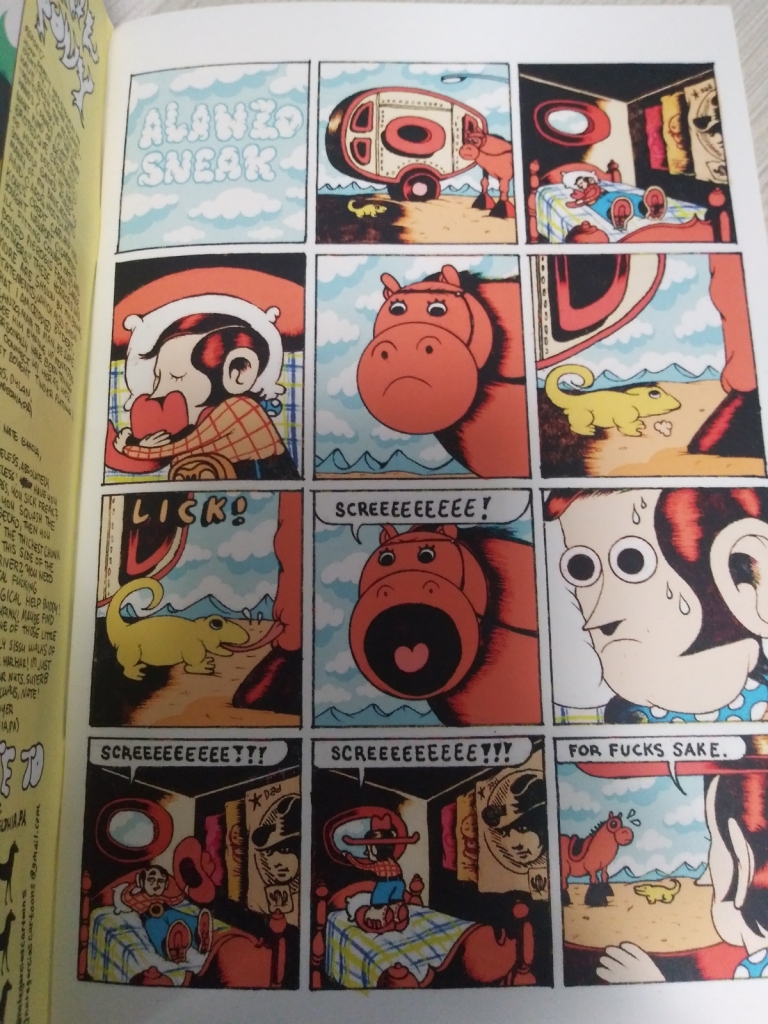
Still, why worry about future eventualities when the present offers such damn good strange fun? And Garcia’s latest, Gecko, certainly is that — not a whole lot happens story-wise, it’s true, but that’s entirely beside the point. Garcia (with a one-page assist at the back of this one from Goiter‘s Josh Pettinger) is more about atmospherics and tonality than narrative ambition, more about the cohesive experience than its reductive elements. The whole has always been greater than the sum of its parts with this Philly-based enfant terrible, and that’s as true as ever here — although those parts deserve special mention.
Specifically, with this new comic Garcia has thrown off the yoke of the magazine format (not that we object to said format around these parts, mind you, but it’s nice to see a self-publishing cartoonist venture out of their comfort zone sometimes) in favor of the old-school A5 (I think, at any rate) ‘zine, and this time he’s opted for a riso-printed cover and full-color interiors. Purely as a physical object, then, this both looks great and feels good to flip through — which rather belies its decidedly modern origins as an Instagram “swipe-though” comic. In fact, petty as it makes me sound, I sorta hope this thing looked like shit on Instagram (I didn’t see it since I don’t have an account on there), because this feels like exactly the right “delivery method” for this material.

As far as what that material consists of, in short : Alanzo stomps on a Gecko, an anthropomorphic Gecko who works at a hamburger stand takes exception to this act of brutality against one of its brethren and — ya know what, I don’t want to give away the fucked-up “joke” that comes after that, so let’s just say Alanzo ends up sicker than hell and leave it at that. And if all that sounds like flimsy grounds to extrapolate a 20-plus-page story from, well — technically speaking you’re absolutely right, but Garcia’s led an extremely charmed life up to now in his still-nascent cartooning career, and that pattern holds true here. There are a couple of punchy little backup strips, as well, so all in all it’s gotta be said that reading this — and oohing and aahing at the art — is a great time.
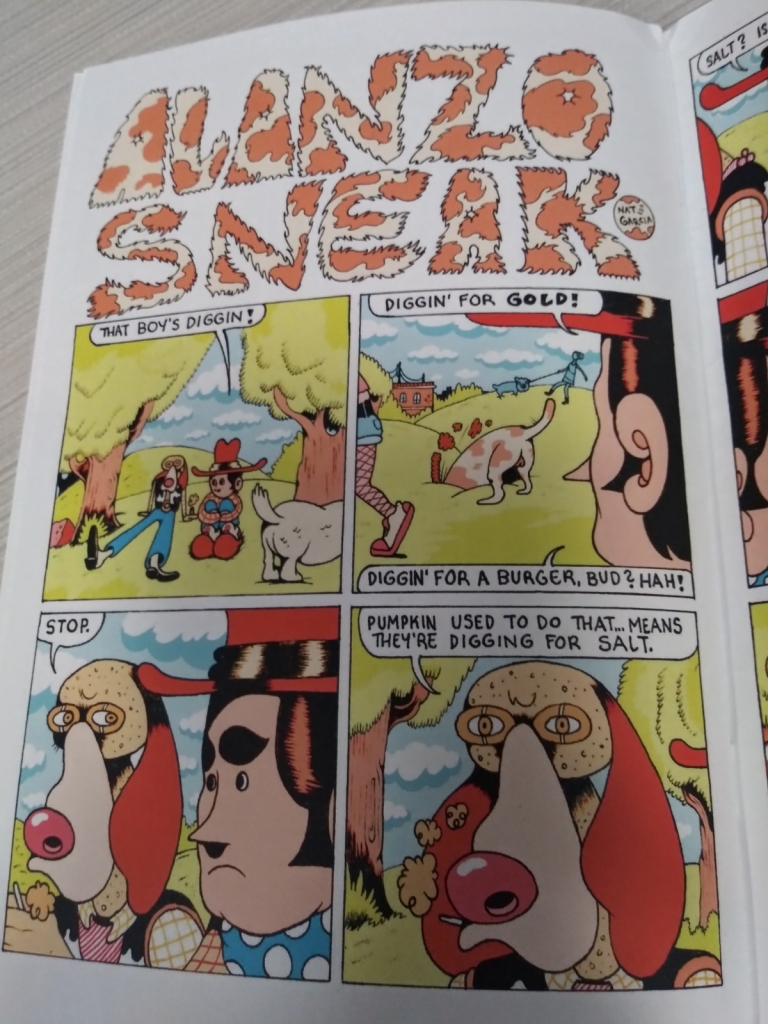
So go on, pick it up and have precisely that. Nate Garcia is one of our weirder and more wonderful comics auteurs of the moment, and there’s no reason to feel the least bit guilty about liking his impeccably-drawn, curiously folksy bizarre surrealist humor. Not yet, at least.
***************************************************************************************
Gecko is available for $10.00 from Nate Garcia’s Bigcartel site at https://nategarcia.bigcartel.com/product/gecko
Also, this review — and all others around these parts — is “brought to you” by my Patreon site, where I serve up exclusive thrice-weekly rants and ramblings on the worlds of comics, films, television, literature, and politics for as little as a dollar a month. Subscribing is the best way to support my continuing work, so I’d be very appreciative if you’d give it a look by directing your kind attention to https://www.patreon.com/fourcolorapocalypse
An Atypical Wreck : Steven Arnold’s “Perry Midlife”

Speaking as someone who’s been there, done that, and is still doing it, trust me when I say that the existential dread that comes with aging is as serious as a fucking heart attack. Certainly, it has to qualify as a “first world problem” — there are any number of countries in the process of being ground under economically, militarily, or both where simply living to see another day is reason enough to be grateful regardless of how many ticks of the calendar one has endured — but that doesn’t mean those of us who have the privilege of even being able to worry about such things aren’t terrified by our own mortality once we hit the point where logic dictates we likely have more yesterdays than we do tomorrows.
Steven Arnold — or, as he credits himself in the work we’re here to look at, S.R. Arnold — gets it. He knows the slow-burn sense of impending doom that the middle-aged person feels is equal parts well-placed and ridiculous, justifiable and self-indulgent, and in the handsomely-formatted pages of the magazine-sized Perry Midlife (the sixth release from his Philly-based H.O.T. Press Comics imprint, and as far as I know his first “solo” work, in that it was done without the assistance of writing partner Michael Kamison), he regales us with the tale of a typically hapless underachiever having anything but a typical time of things — even if, again, this is a decidedly typical set-up on its face.
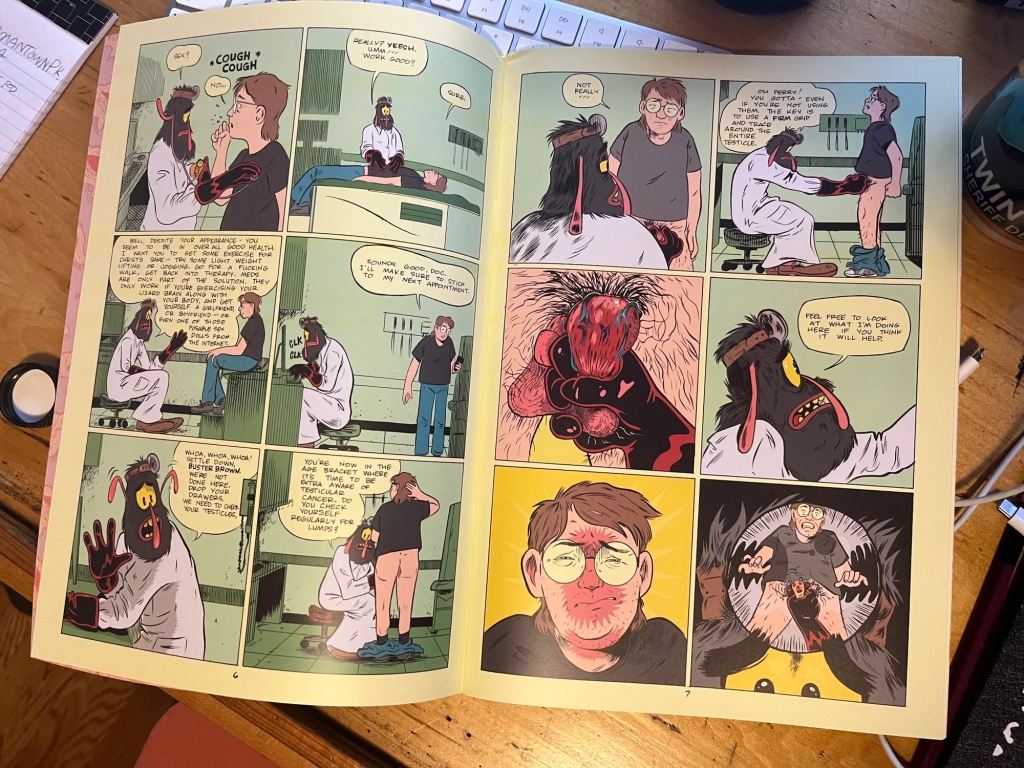
Anyway, how much of what’s happening on the lavishly-colored pages here is “real” or not is beside the point, I suppose, what’s of greater import is the overall relatability of both our titular Perry and his befuddled mindset, and Arnold absolutely nails that. Admittedly, there’s a bit of “high weirdness for its own sake” on offer here — check out our man’s doctor, pictured above, for instance — but if you can’t wrap your head around the concept of a perpetually-annoying fake ornithological species called a cowbird, what can I say? This ain’t the comic for you — but it’s only yourself that you’ll be depriving.
Okay, fair enough, “depriving of what?” is the natural enough follow-up question here, and the answer is a complicated one. Of enjoyment? To a degree, absolutely — I mean, this is a funny comic. But it’s not necessarily an easy one to enjoy, depending on one’s internal wiring. Mine is hopelessly skewed, so I did have a fair amount of fun with this, but there are times when Arnold’s personal flights of fancy can fairly be said to blunt the impact of otherwise-strong narrative “beats” and where he gets the delicate real/surreal balance he’s playing with throughout just a bit wrong — these instances are notable, though, which is as good an indicator as any that most of the time, at any rate, he’s getting things exactly right.
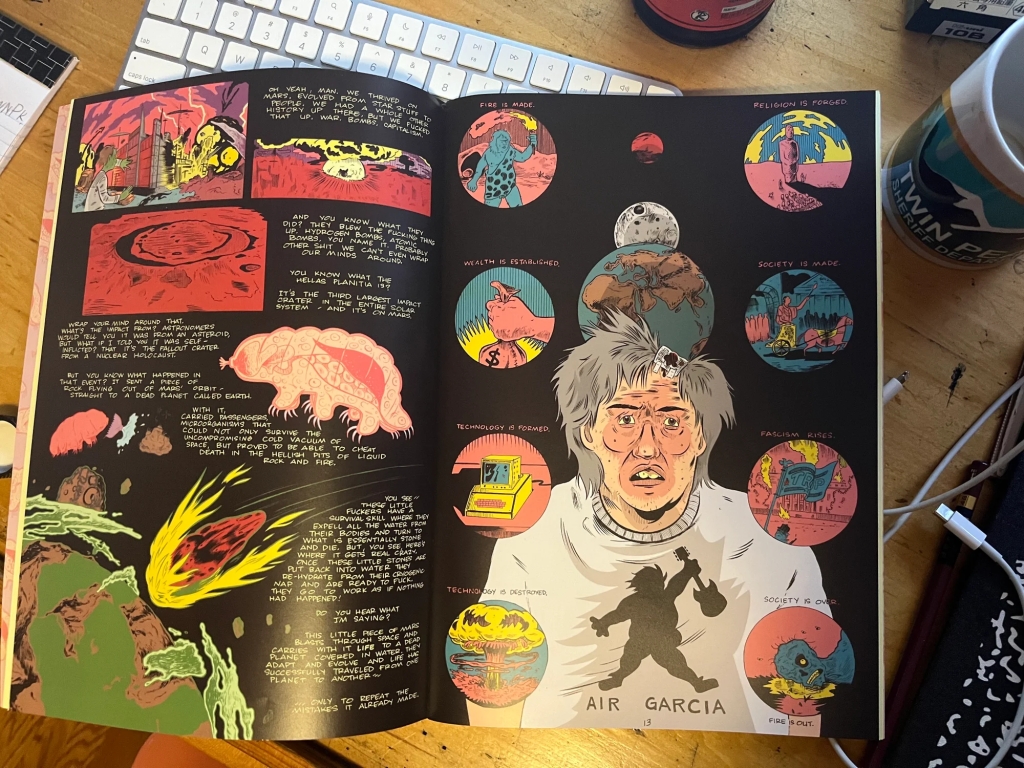
It helps, of course, that Arnold is such a great fucking cartoonist — his compositions are crisp and imaginative, his figure drawing is technically near-flawless, and his layouts run the gamut from standard-issue to pretty damn far-out with gusto and aplomb. He’s not afraid to challenge himself either conceptually or concretely, and the results speak for themselves : the guy is in full command of some fairly considerable creative powers, and stands out as one of the bright lights in what is arguably America’s most vibrant local cartooning scene. You pass on his stuff at your peril.

What’s not to like, then? Well, not much, if we’re being totally honest here — and we always are. Tonally, Arnold might be struggling to break free from the Clowes/Ware paradigm, at least to an extent, but his outlook and approach are unique unto himself, even if his overall set of concerns here isn’t. I’m anxious to see where he goes next, absolutely — but for purposes of this review, I’ve gotta say I’m quite impressed with where he is right here and right now.
********************************************************************
Perry Midlife is available for $12.00 from the H.O.T. Press Comics website at https://hotpresscomics.bigcartel.com/product/perry-midlife
Also, this review — and all others around these parts — is “brought to you” by my Patreon site, where I serve up exclusive thrice-weekly rants and ramblings on the worlds of comics, films, television, literature, and politics for as little as a dollar a month. Subscribing is the best way to support my continuing work, so I’d be very appreciative if you’d take a moment to give it a look by directing your kind attention to https://www.patreon.com/fourcolorapocalypse
There’s No Such Thing As Ordinary : Alex Nall’s “Town & County” #1
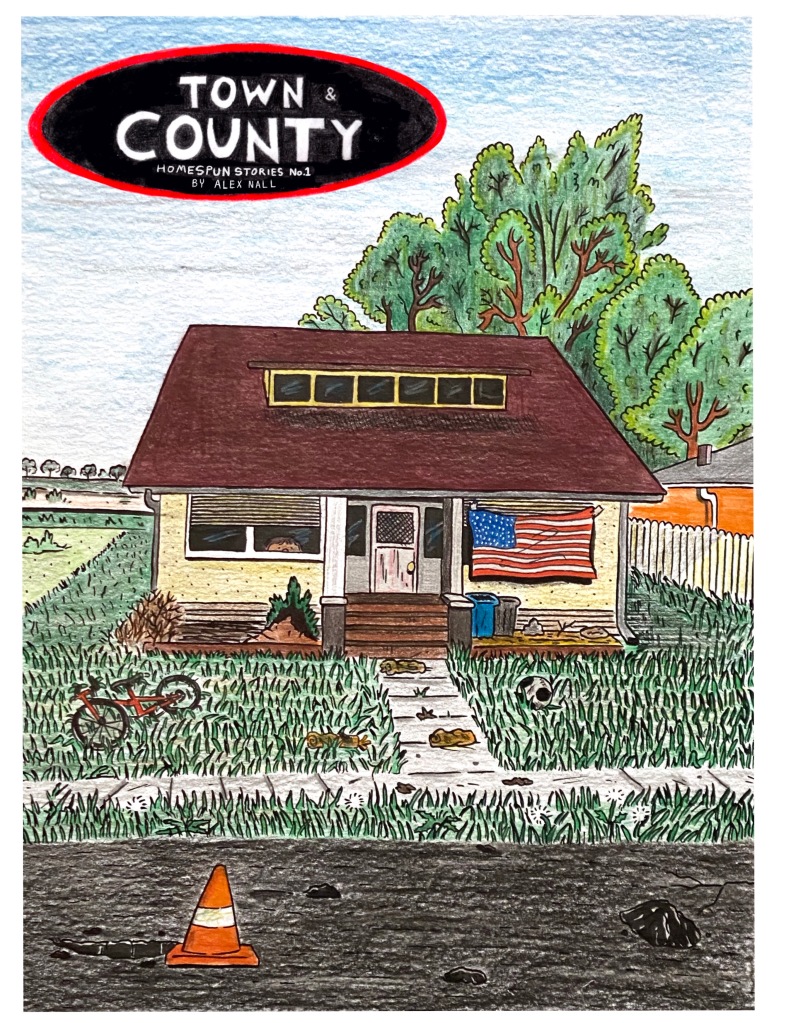
If you’ll cast your mind back to the admittedly dark later days of 2016, you’ll recall that there were two common reactions from the so-called “coastal elites” with regard to the electoral college victory of a certain syphilitic game show host who is now, according to his closest former aides, living in some kind of thick bubble of reality denial (as if he wasn’t back then) : one was to give his voters in the so-called “heartland” the old fly-under-a-magnifying glass treatment, thereby subjecting readers of the New York Times and other outlets to one interminable series of profiles after another, ostensibly designed to provide “insight” into the lives of “the forgotten men and women of middle America,” while the other was to quickly glom onto this supposedly-ascendant subset of Americans and portray Trump’s rather flukey (if we’re being completely honest) win as “the revenge of flyover country.”
Both entirely-manufactured points of view did the REAL men and women of small town and rural America a disservice, of course, in that they forced them to be either curious holdovers of a bygone era or hard-working “salt of the Earth” types fed up with supposedly being talked down to by their self-appointed social “betters,” but they also both had the curious effect of letting the real culprits for the rise of neo-fascism off the hook, in that neither editorially-dictated point of view bothered to look at the simple, oft-repeated precedent of history, to wit : people who have been screwed over by the rich have always been easy prey to do the bidding of those selfsame rich folks as long as you can direct their anger somewhere other than where it belongs. Don’t blame the billionaire class for raising your health insurance premiums astronomically, looting your formerly-secure pension fund, shuttering the factory you used to work at and opening one in Mexico the following week, or gouging you at the grocery store checkout line. Blame, uh — well, whoever else you can, from transgender athletes to starving migrants fleeing war-torn countries to gay school teachers to supposedly “violent” inner-city youths. Yeah, there you go — your problems are their fault.
Lost in the sudden urge to either attack this so-called “real” America, embrace it, or manipulate it for political gain, however, is the simple fact that “these people” are still real people, and not all of them are easily reduced to the role of pawns in a game. Hell, even those who are still have hopes, dreams, and aspirations like anyone else, and while none of this — I repeat, absolutely none of it — excuses the petty prejudices at the heart of Trumpism (to say nothing of the whopping prejudices that animate its virulent offshoot movements such as QAnon, The Proud Boys, The Oath Keepers, and the Three Percenters), there is, I think, a real danger in focusing only on prejudice when talking about how “middle America” came to find itself in the state it’s in.
Is it really that hard to blame greedy rich bastards for the mess they’ve left in their wake? In America, apparently, it is. But I digress —
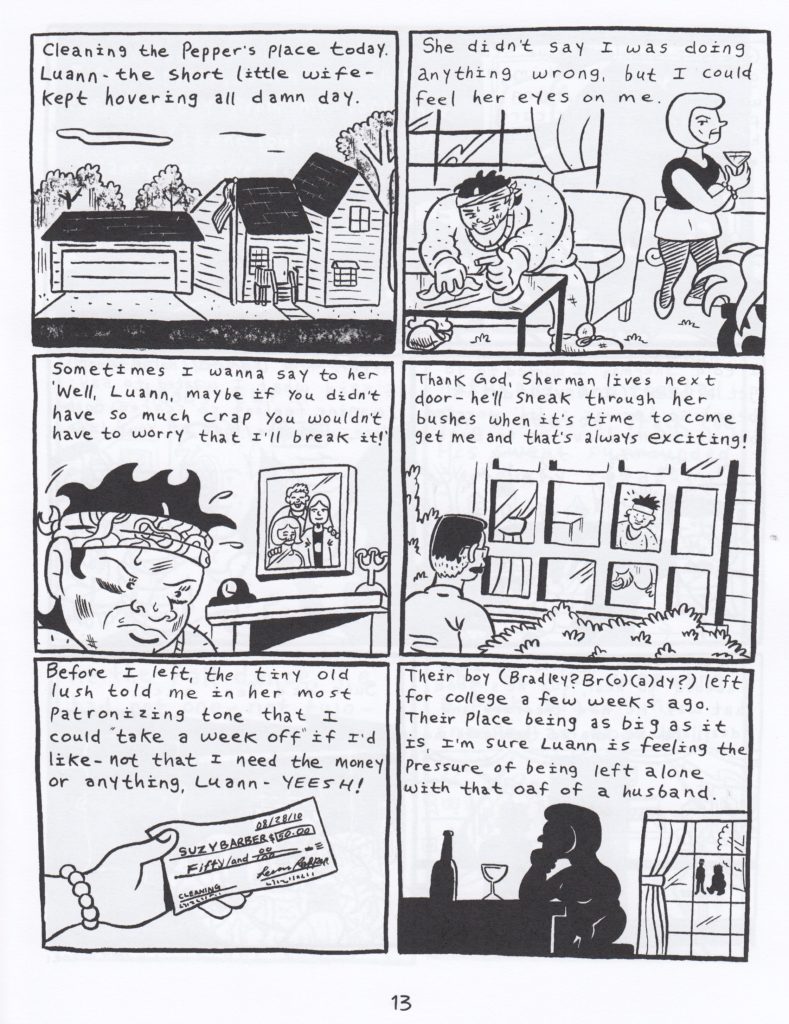
Still, while the journalistic class may have lost sight of much of the richness of small-town life, our cartoonists have not : Sean Knickerbocker and his coterie of contributors are delineating its highs, lows, and in-betweens in the fine Rust Belt Review anthology series, for instance, and Alex Nall has shown an uncanny ability to communicate its quiet idiosyncrasies in the pages of Lawns, Kids With Guns, and the first magazine-sized issue of his new ongoing project, Town & County — which liberally drops references to, and even borrows concepts from, the pair of earlier comics just mentioned, while crafting something new and substantial that requires no intimate knowledge of either of them. In other words, if this is your first step into what we’ll call, with apologies to the author, the “Nall-verse,” you needn’t worry : the welcome mat is rolled out for you.
Which rather strikes me as apropos of the general attitude of the citizenry of the fictitious-in-name-only Clydesdale, Illinois, the “everyday America” setting of the four interconnected vignettes that comprise this debut issue. Longing for something better — or at least for something else — is something all of our protagonists (a lonely widower, a nosey housecleaner, a tortured insomniac, and a low-rent drug dealer) have in common, and while I have no practical experience with “rural Americana” myself, being a lifelong (and, for the record, damn proud) inner city resident, I found all these folks easy to identify with because that tug that exists in the space between wishing for a return to the familiar and yearning for even modestly new vistas of experience is pretty well universal in nature.

Nall, for his part, just so happens to be able to put that dichotomy into words and images better than most — hell, better than almost any of his contemporaries, and he’s got a project here that plays to all his strengths : authentic dialogue paired with rich inner monologue, clean expressive figure lines paired with rough-hewn, entirely unglamorous backgrounds/locales. There’s a push and pull sub rosa tension that animates both writing and art here, and why the hell wouldn’t there be? That pretty much sums up the lives of his characters in a nutshell, whether they consciously realize it or not.
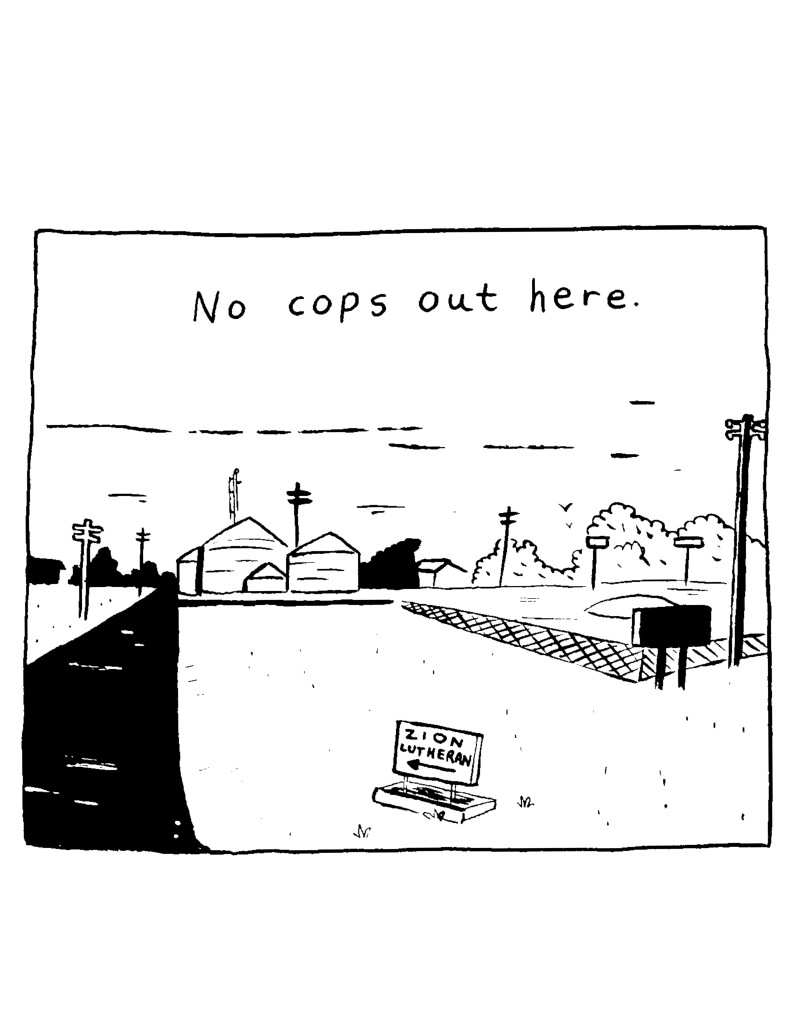
This, then, really is what you think it is going in : a comic about a town and its people — one that eschews the easy trappings of both Norman Rockwell cliche and anti-Rockwell “darkness on the edge of town.” This is a place where bathtub meth slingers and broken-hearted oldsters coexist while inhabiting entirely different personal realities. Where 2nd Amendment militia nuts fill their gas tanks at the same place as frightened mothers who would do anything to protect their kids from the next school shooter. Where the John Deere plant that was the source of everyone’s employment, either directly or indirectly, has shut its doors and left whatever survivors stuck around scrambling to find a new way forward. Where the end of the world has already happened and any promise — no matter how ephemeral and/or fraudulent — to bring back the “good old days” is better than nothing. It’s a place like thousands of others, sure — but that doesn’t mean it’s anything other than utterly unique.
***********************************************************************
Town & County #1 is self-published by Alex Nall under the auspices of his Ivy Terrace Press imprint and is available for $8.00 from his Storenvy site at https://alexnallcomics.storenvy.com/products/35138617-town-county-no-1
Also, this review — and all others around these parts — is “brought to you” by my Patreon site, where I serve up exclusive thrice-weekly rants and ramblings on the worlds of comics, films, television, literature, and politics for as little as a dollar a month. Subscribing is the best way to support my continuing work, so I’d be very appreciative if you’d take a moment to give it a look by directing your kind attention to https://www.patreon.com/fourcolorapocalypse
The Other Side Of The Fold : Robb Mirsky’s “The Lemonade Brigade”
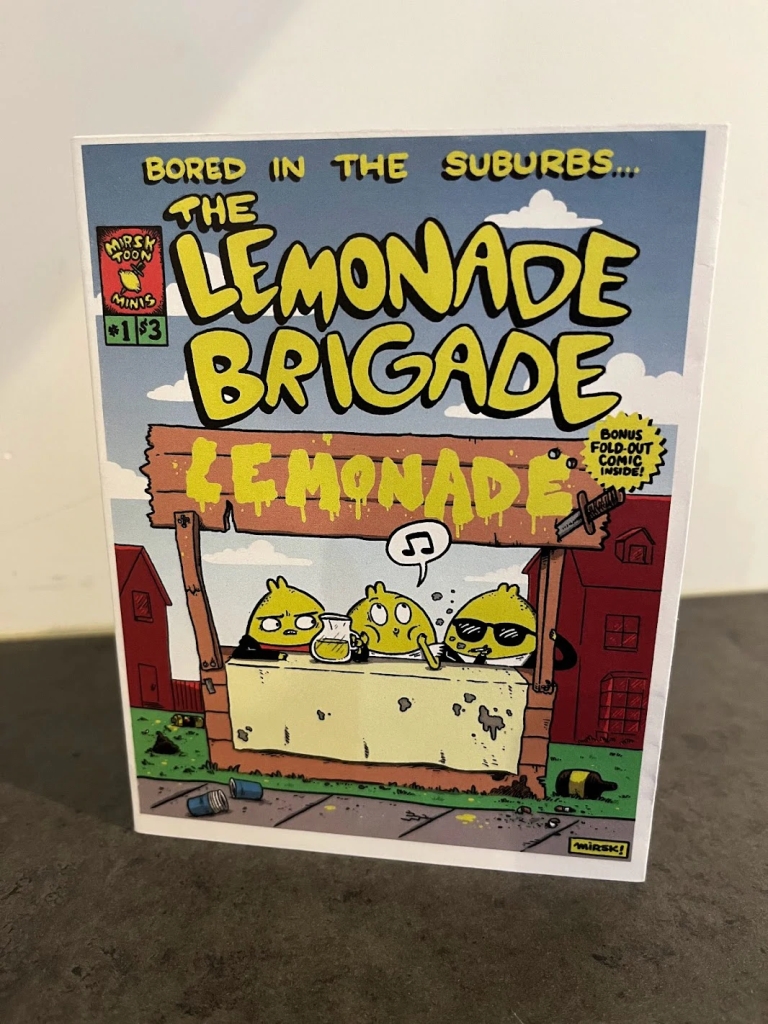
The “tag line” above the title of Robb Mirsky’s new self-published mini The Lemonade Brigade tells you right away that he gets it : why do kids in the suburbs tend to get themselves into any kind of trouble they can find? Because they’re bored — and they damn well should be! When you’re surrounded by people (or, in this case, lemons) who have traded in happiness for the single-dullest approximation of security one can imagine, people who are literally running out the clock on their own lives, you’ll do anything to relieve the tedium. Especially, I suppose, if those people are your own parents.
To that end, most of the juvenile delinquency on offer in these pages is as utterly pointless as such acts of quasi-rebellion tend to be in real life : nobody’s got the brains or ambition to really throw a spanner in the works of the system, so they just “tag” the same walls with graffiti over and over again (among other ultimately pointless endeavors), not so much actively hoping to get caught as they are not really giving a fuck either way. After all, the question of “Why did you do it, son?” is one that only has one answer in suburbia : “Because it was something to do.”

So, yeah, apart from the fact that these comics feature citrus-based life forms, they’re eminently relatable to anyone who either had or is having a standardized, routine upbringing in a consumer-driven community centered around the principle of protracted soul-death on the installment plan. I laughed at something on every page, and that’s basically a Mirsky staple — even if this comic, for entirely practical (yet no less innovative for that fact) reasons actually has no staples. Ya see, what it has instead is something much better : a “B”-side comic of the following strip presented in fold-out form :
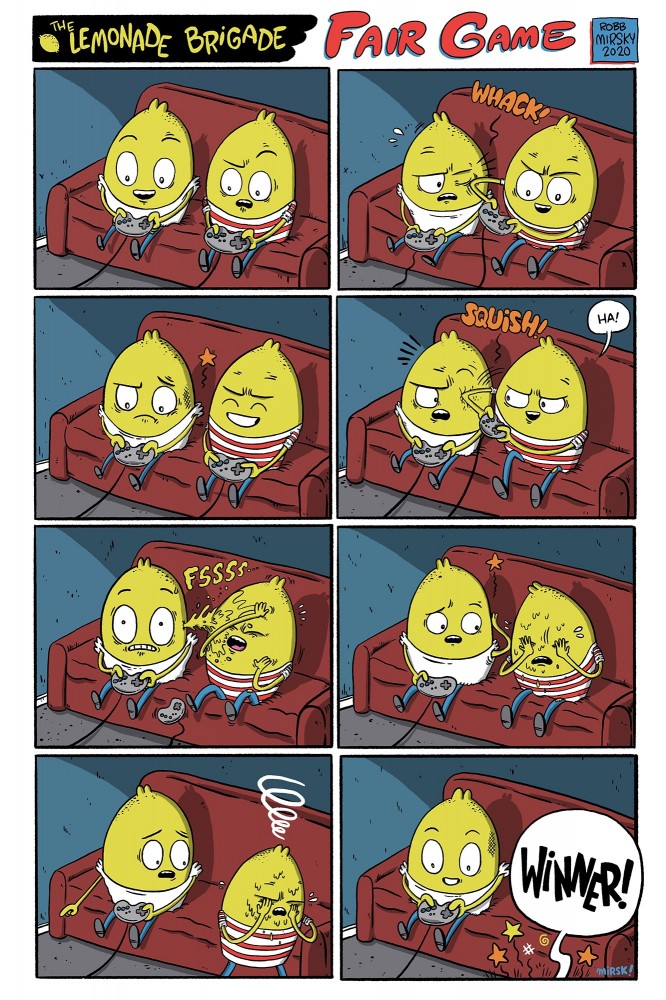
Okay, fair enough, it’s a gimmicky idea — but that doesn’t preclude it from being a cool one. Which is also a feature common to all things Mirsky : he has a habit of reminding you why you like certain things simply because he does them so damn well. “Old hat” ideas like muck monsters and anthropomorphic stands-ins for human beings seem fresh, new, and fun again when he’s doing them because he has an uncanny knack both for zeroing in on why these sorts of gimmicks (there’s that word again) were both fun and effective in the first place , and for tossing aside the extraneous baggage that they’ve been saddled with over the years that’s sapped all that fun and effectiveness out of them. They say that everything old is new again, and I suppose that’s true or they wouldn’t keep saying it, but it takes a special talent to make a reader glad that it’s new again. I humbly submit that Mirsky is, indeed, a special talent of precisely that sort.
Looking at things more broadly, it’s fair to say that slapstick gets a bad rap in these pseudo-sophisticated and painfully self-aware times we live in, but when it’s done smartly, and has a point? It’s not only still funny and salient in equal measure, it’s also fiendishly clever, especially when it’s of the painfully obvious “I wish I’d thought of that — in fact, why didn’t I?” variety. All of which is to say that the observations at the beating heart of these gag strips well and truly don’t require any sort of special level of insight — but they most certainly do require skilled comedic timing and a mastery of “Comics 101” visual storytelling basics in order to land properly. If, then, you’re the sort of person who values and appreciates sheer old-school cartooning skill, you’ll find this charmingly unassuming mini to be one that you derive a fair amount of honest-to-goodness joy from.
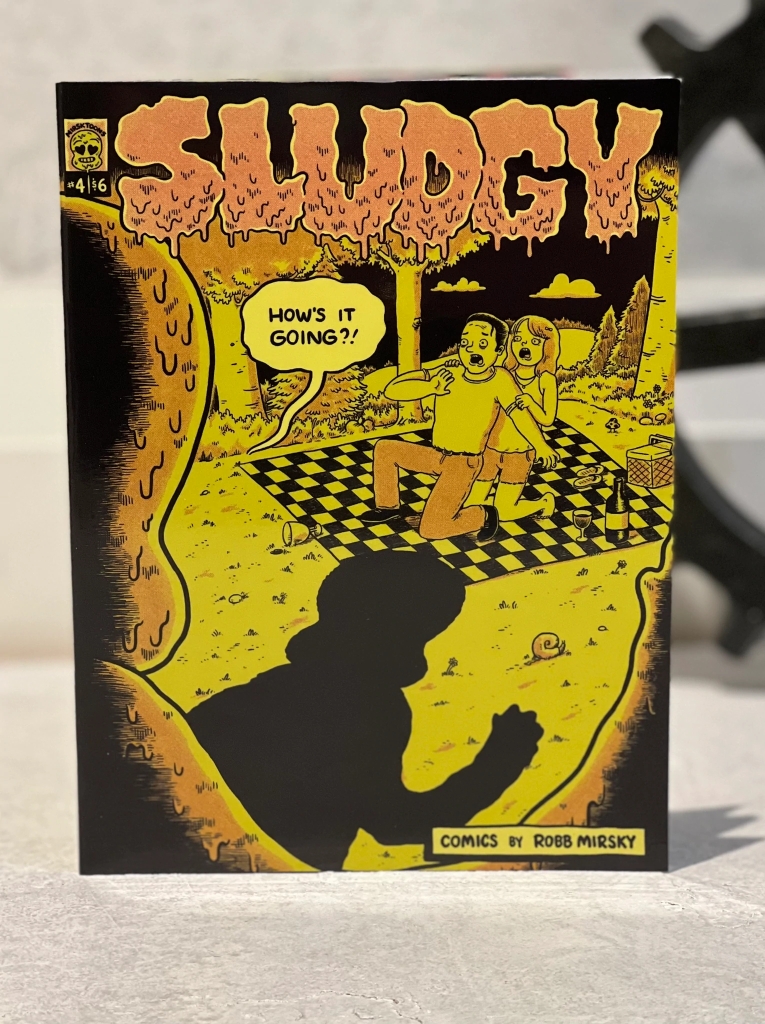
And speaking (again) of muck monsters, Mirsky has also just released the latest and greatest issue of his infectiously likable series Sludgy, which is #4 to be precise, and you don’t want to pass on that, either. I have, however, talked about that title plenty in the past, so I made it my goal this time out to demonstrate to you, dear reader, that this guy is much more than some one-trick pony. He’s the real deal, and he’s making some real good comics.
***************************************************************
The Lemonade Brigade is available for $3.00 from Robb Mirsky’s website, My Moving Parts, at https://mymovingparts.com/collections/comics/products/lemonade-brigade-mini-comic
Also, this review — and all others around these parts — is “brought to you” by my Patreon site, where I serve up exclusive thrice-weekly rants and ramblings on the worlds of comics, films, television, literature, and politics for as little as a dollar a month. Subscribing is the best way to support my continuing work, so I’d be very appreciative if you’d take a moment to give it a look by directing your kind attention to https://www.patreon.com/fourcolorapocalypse
